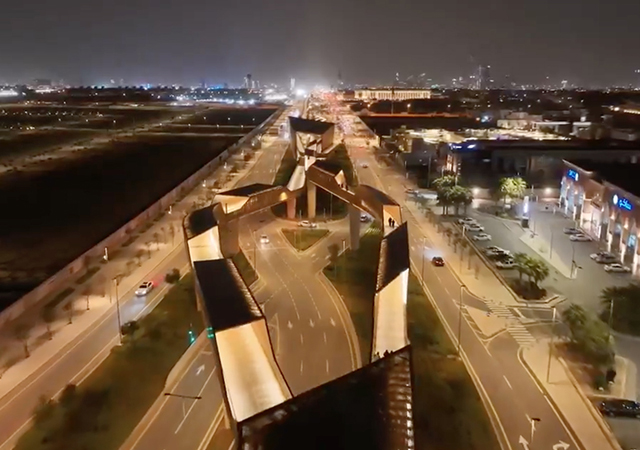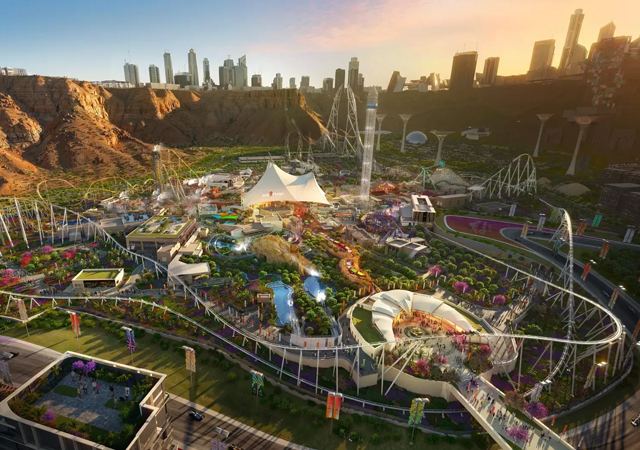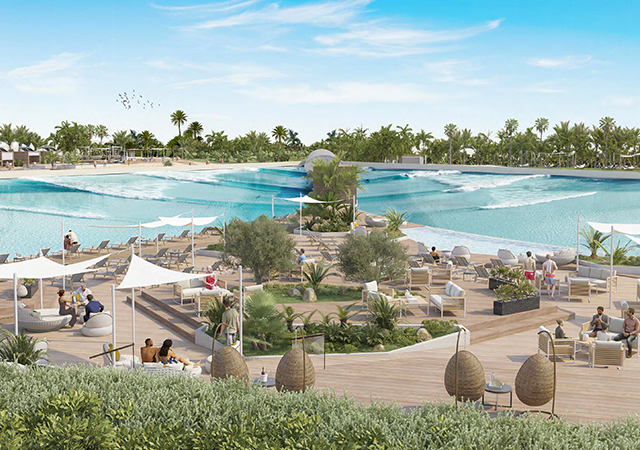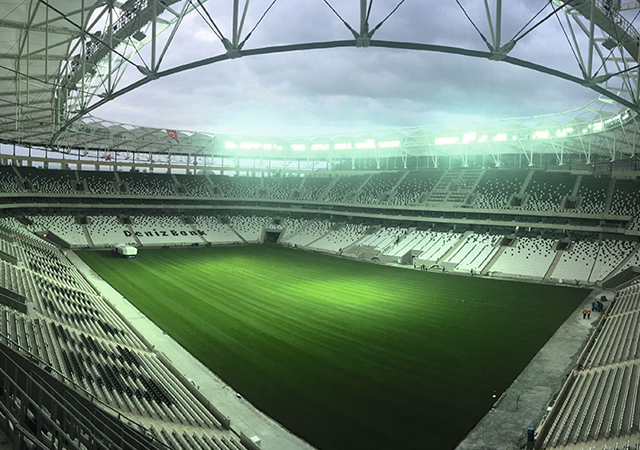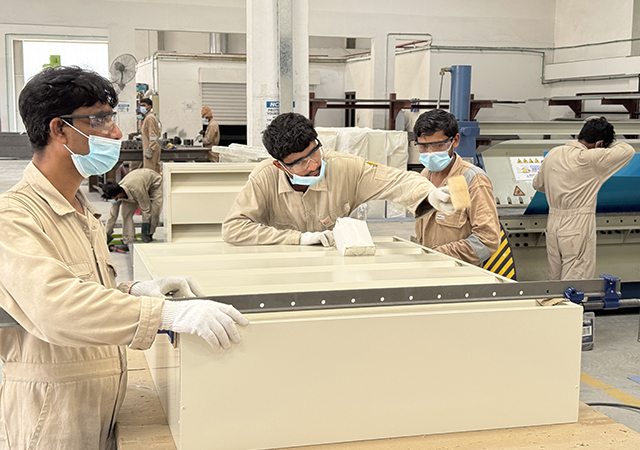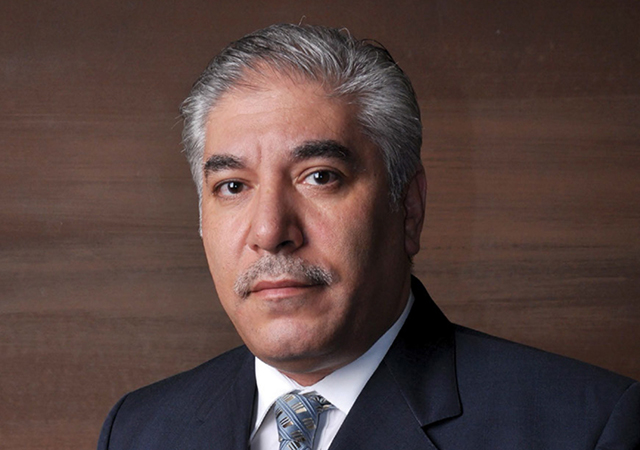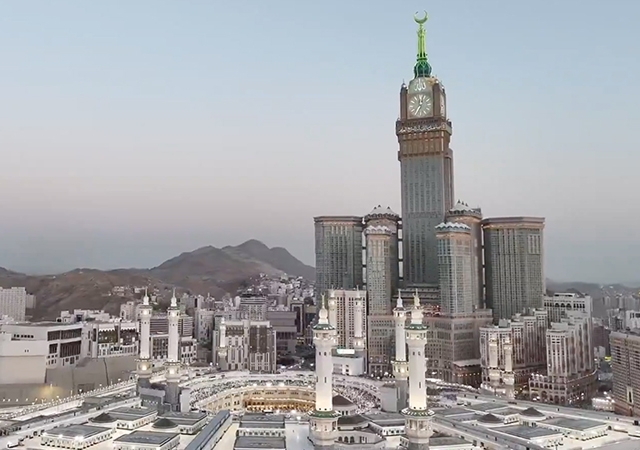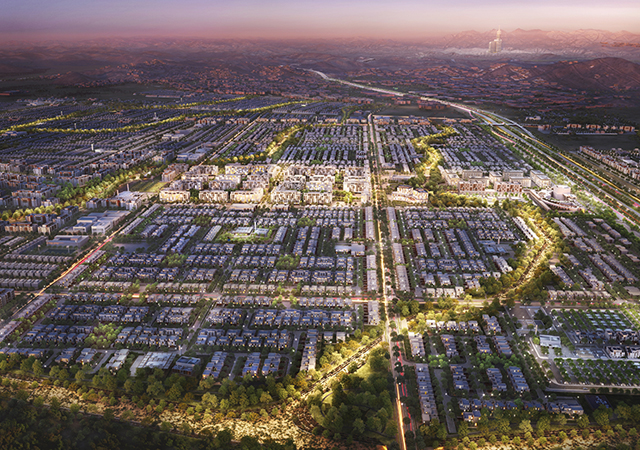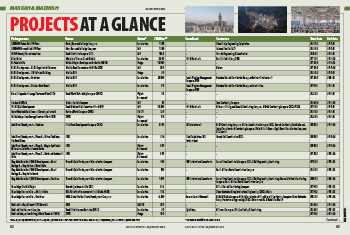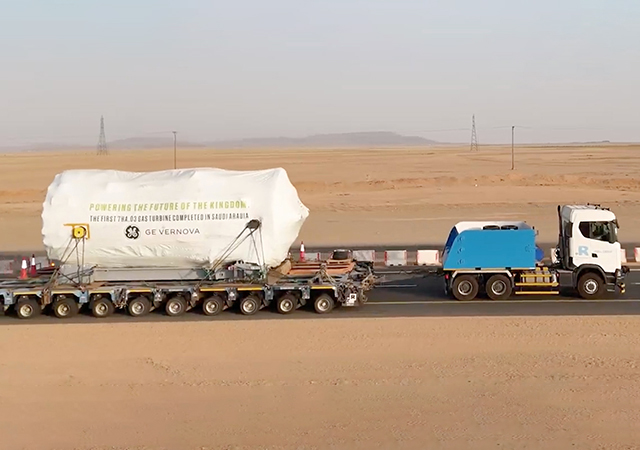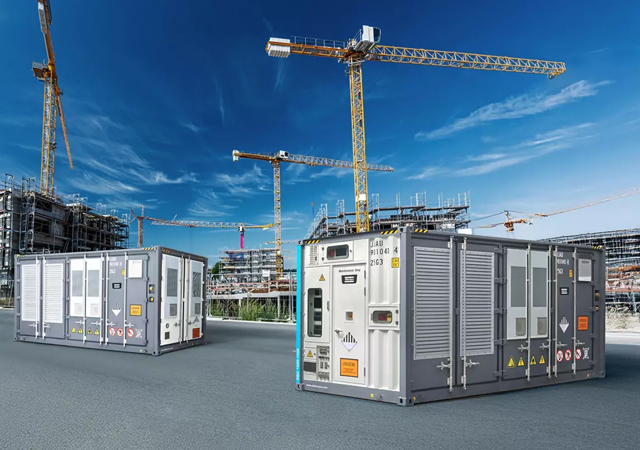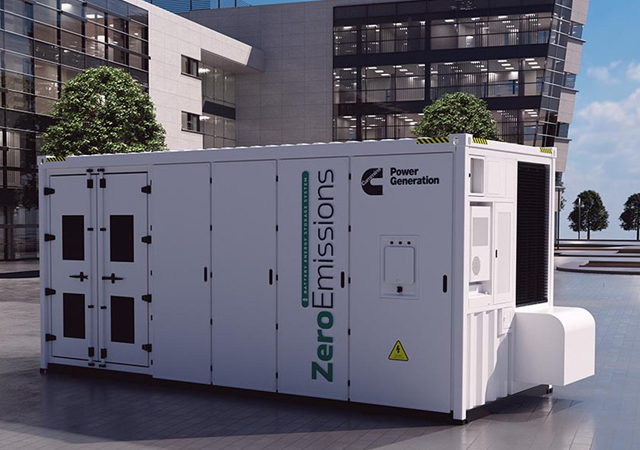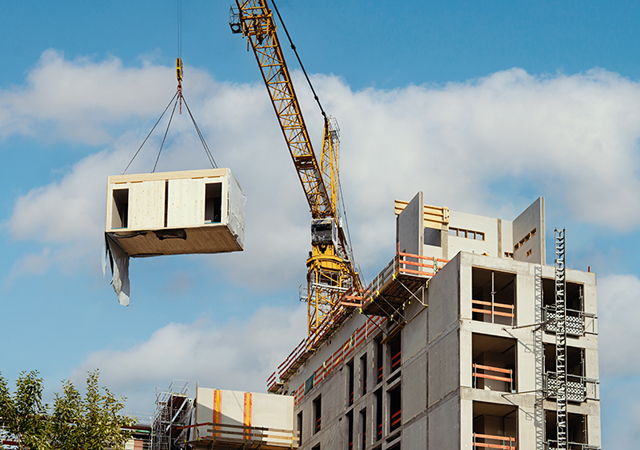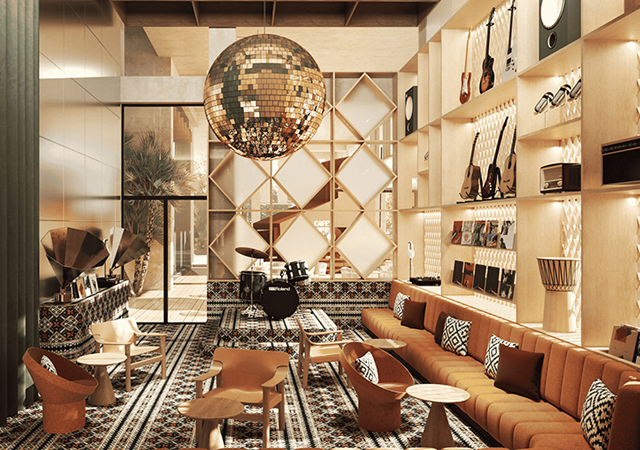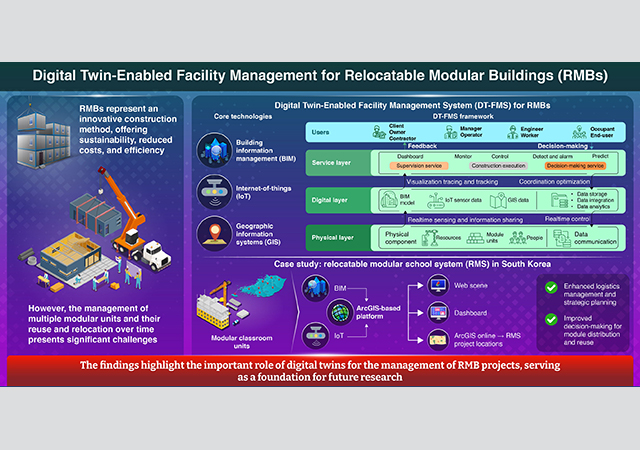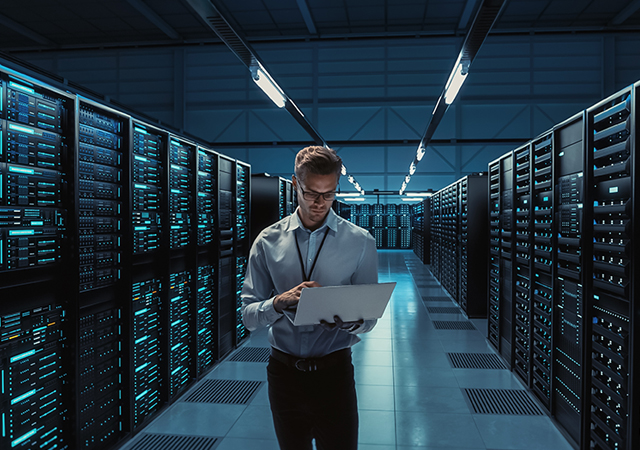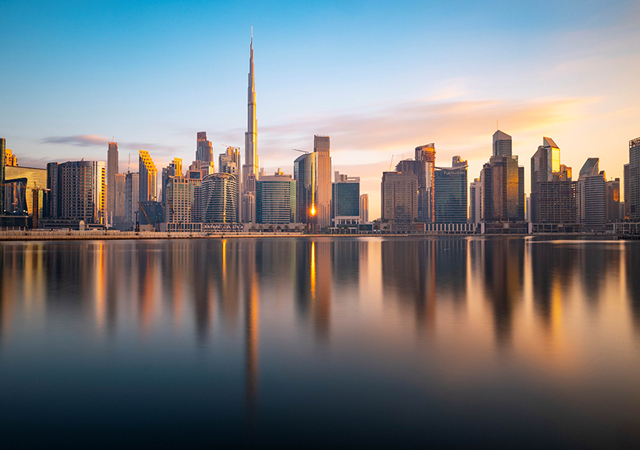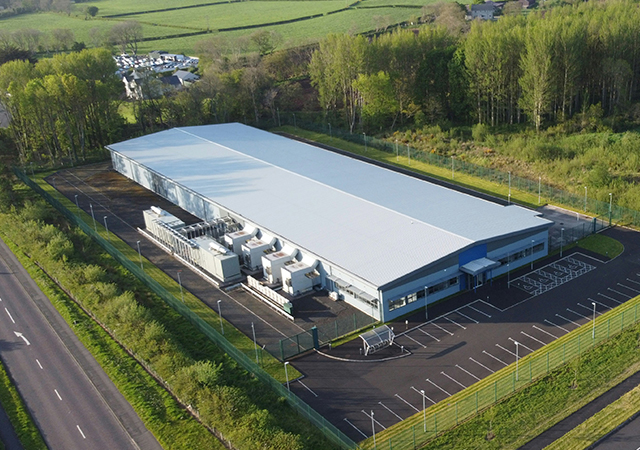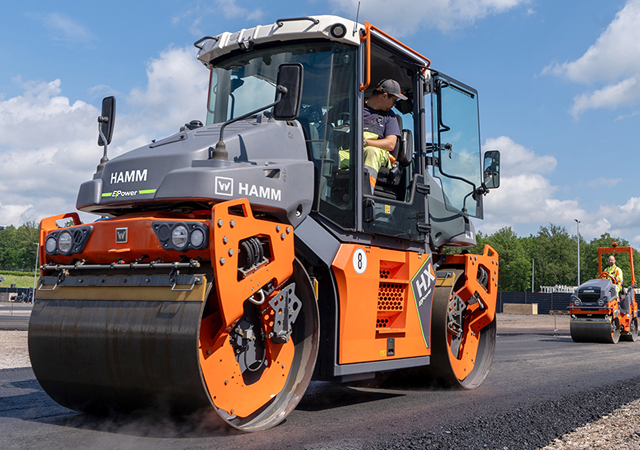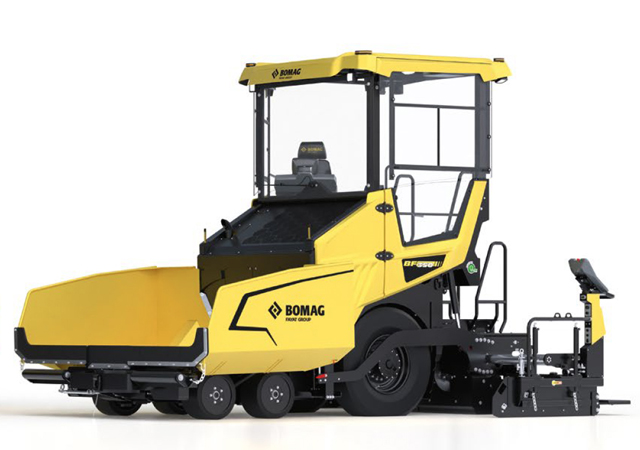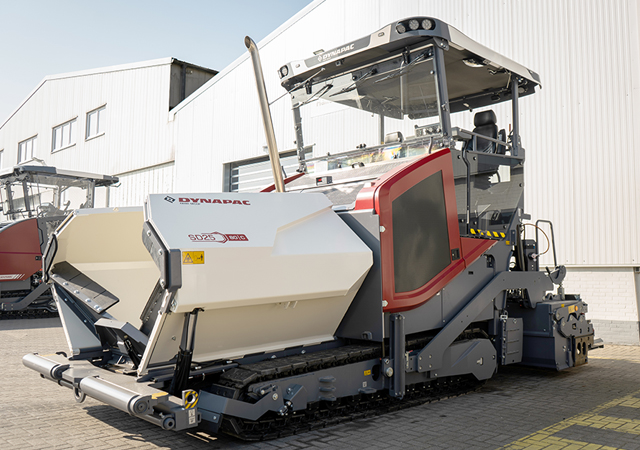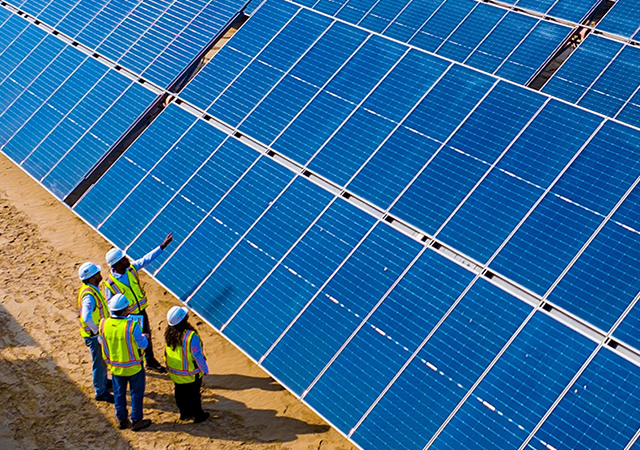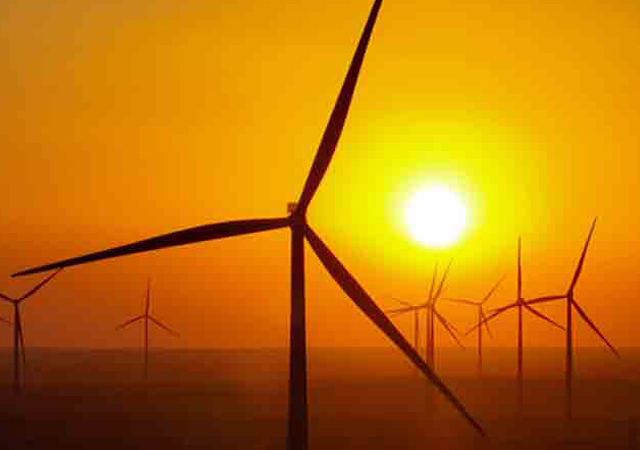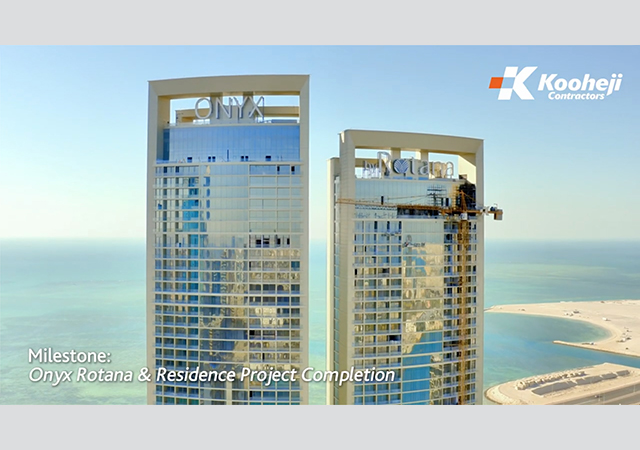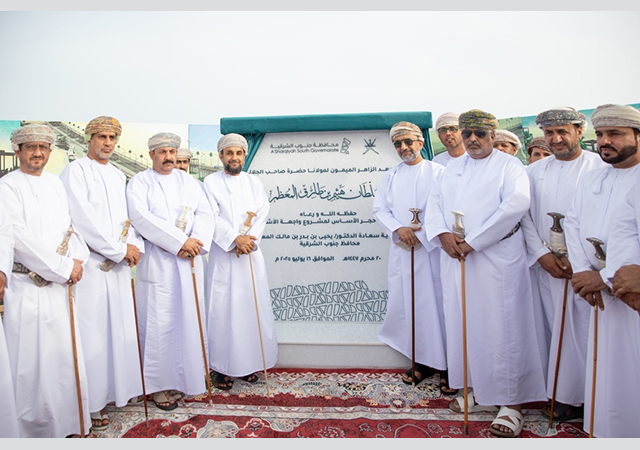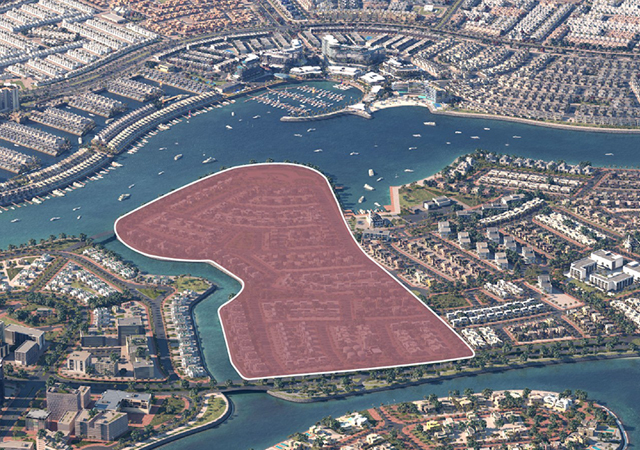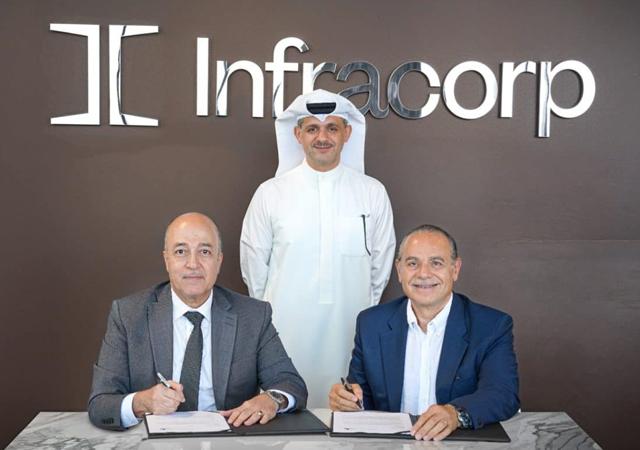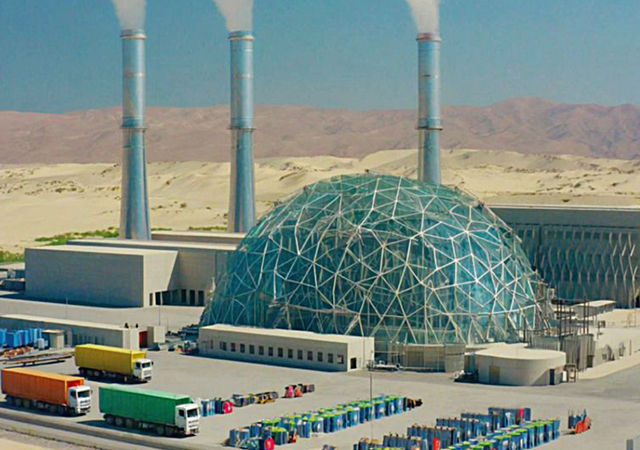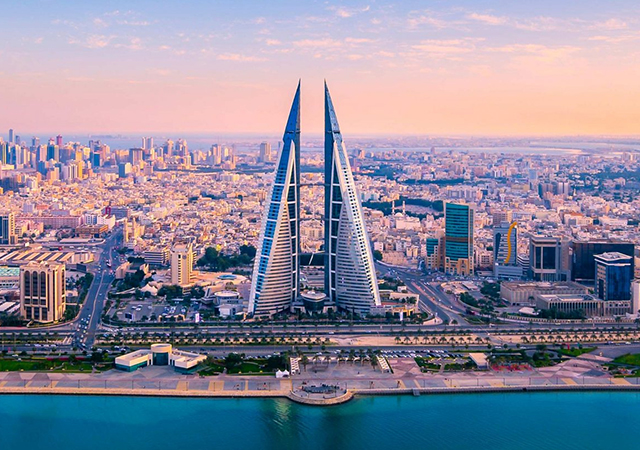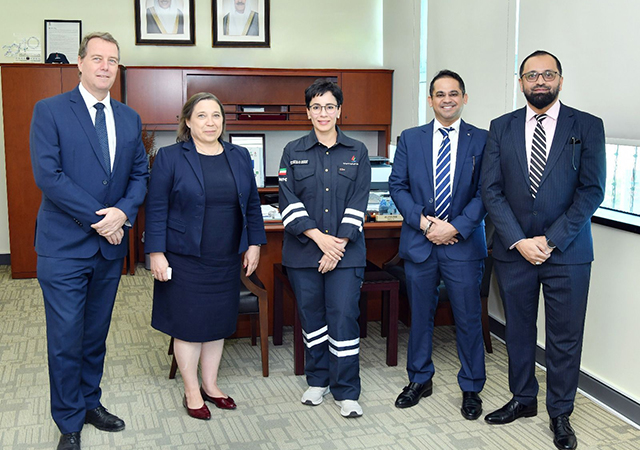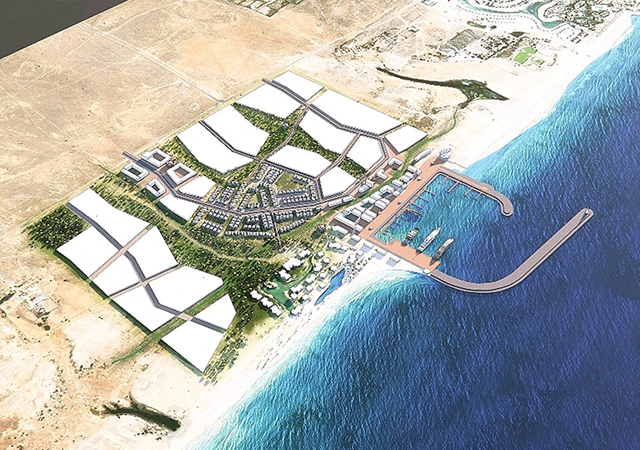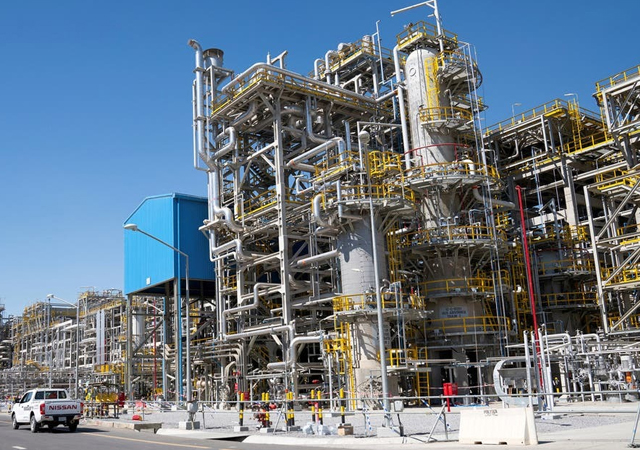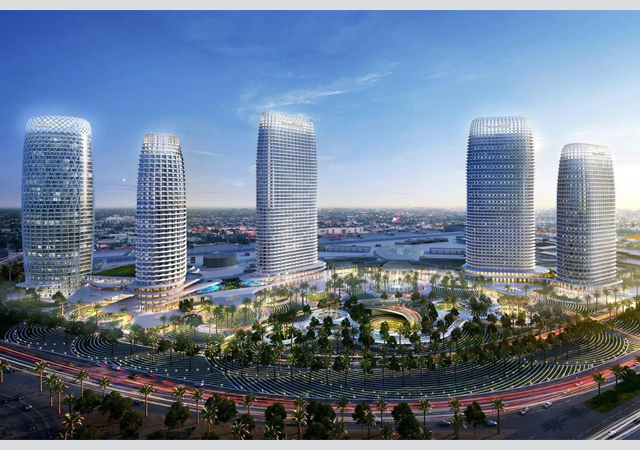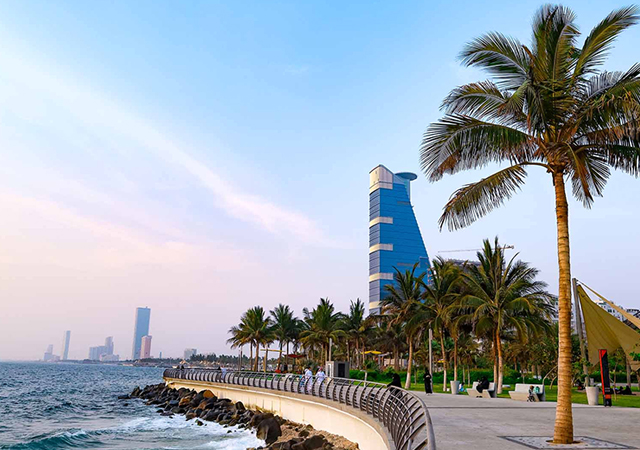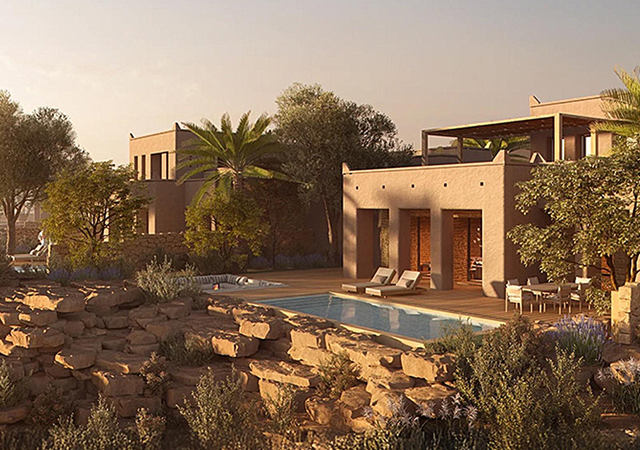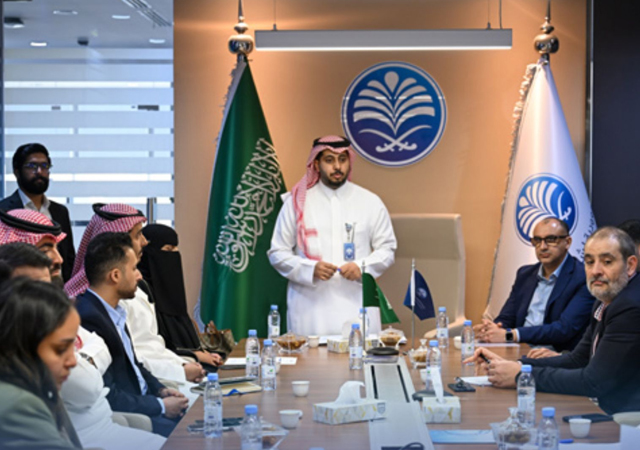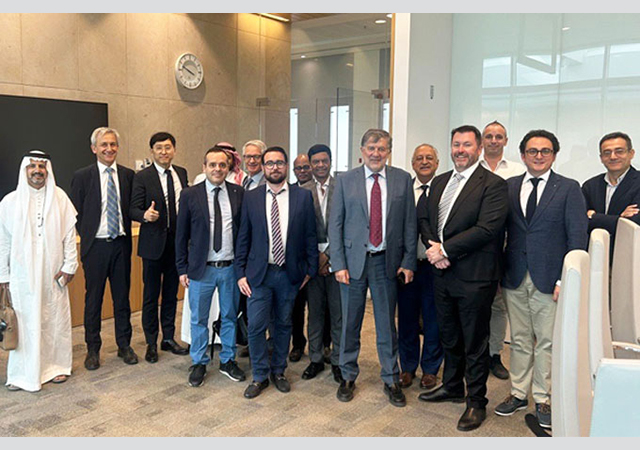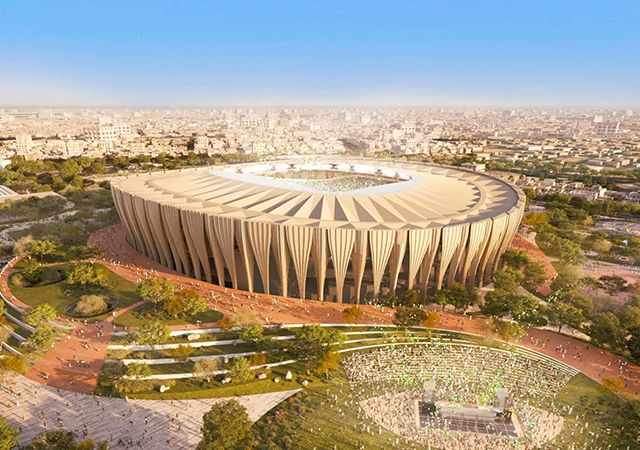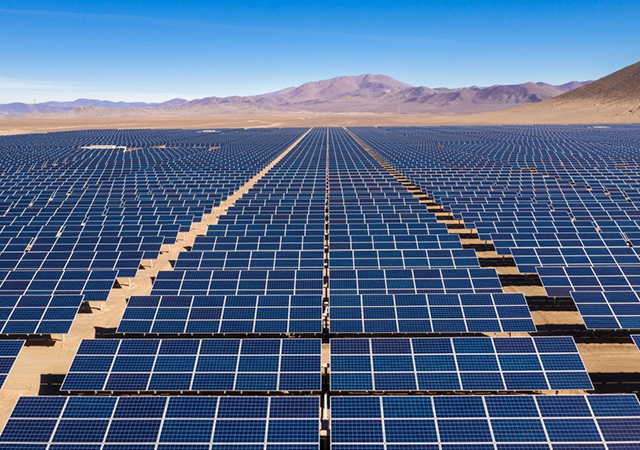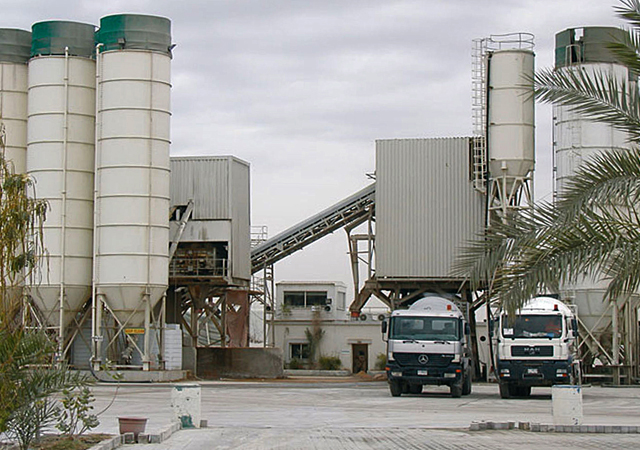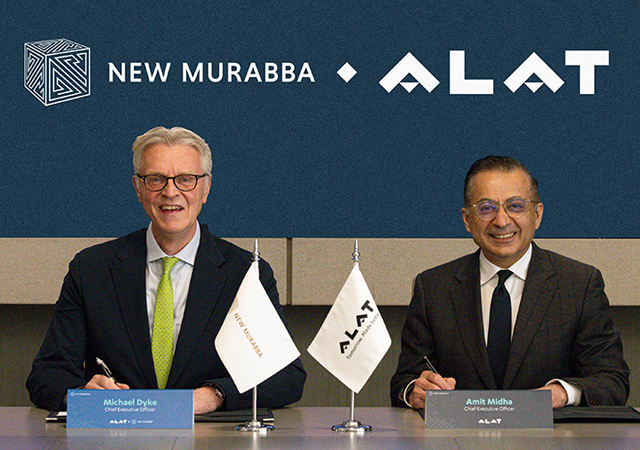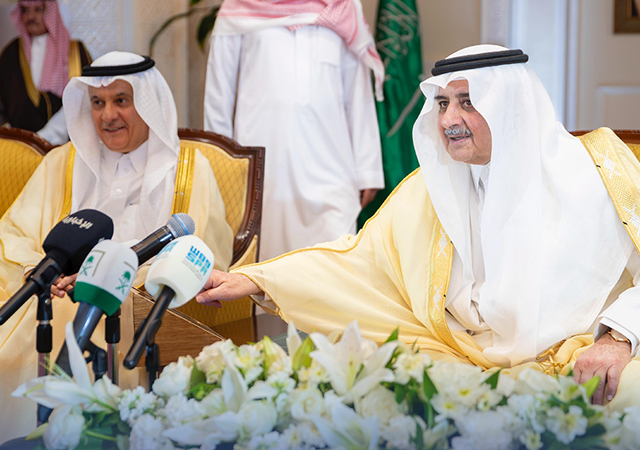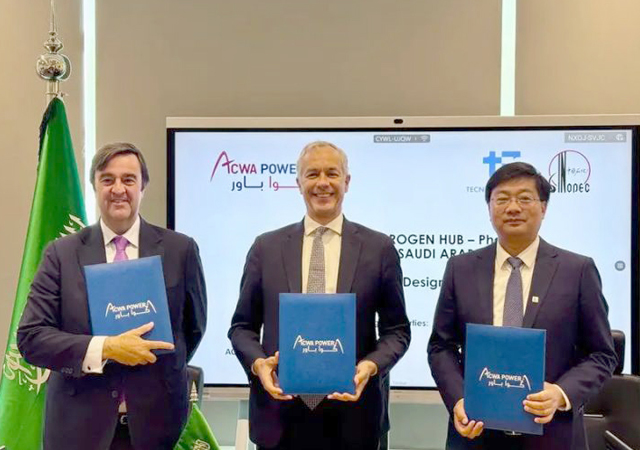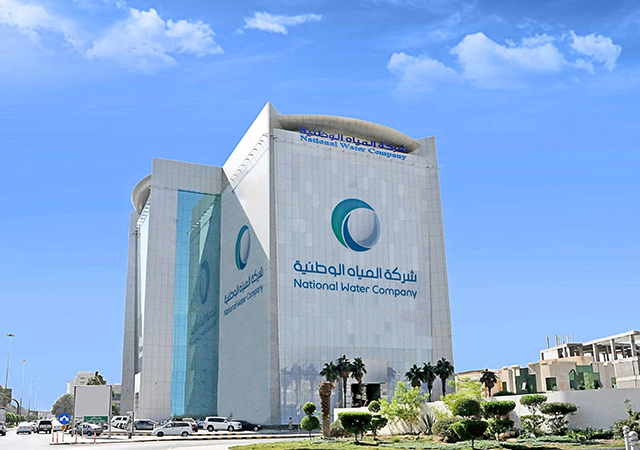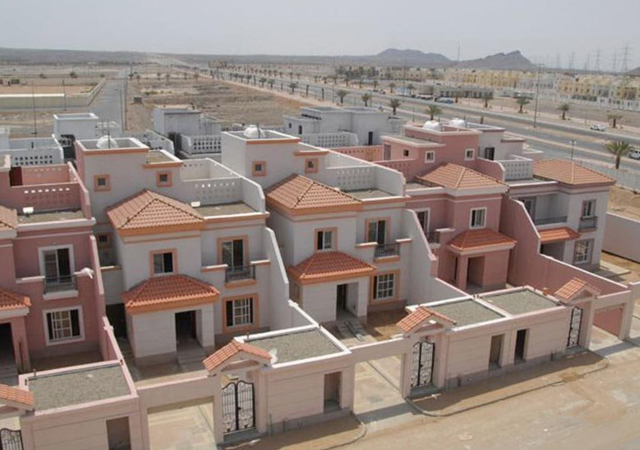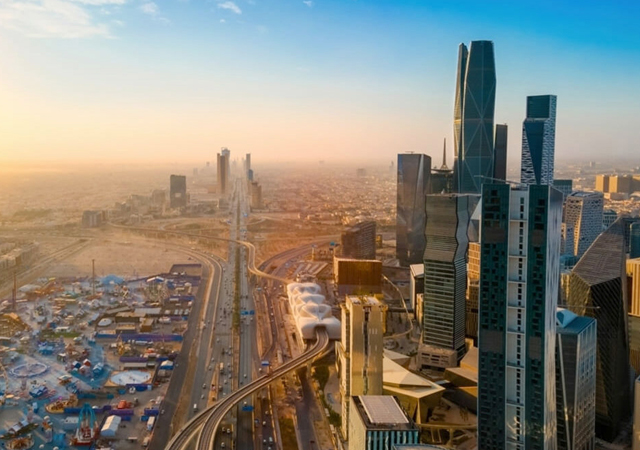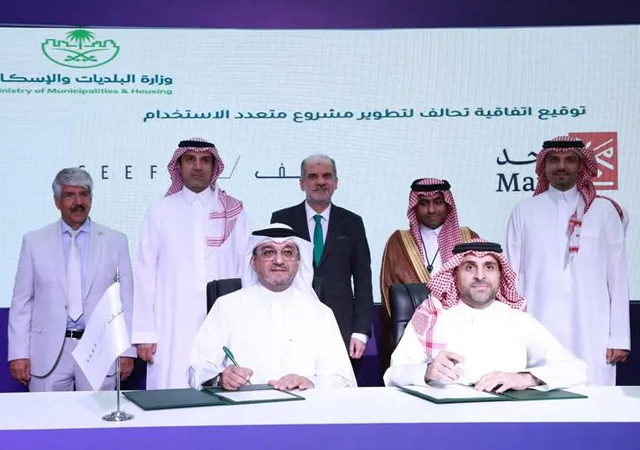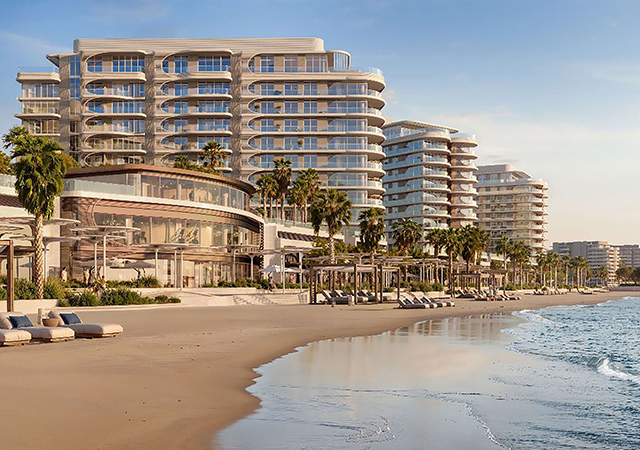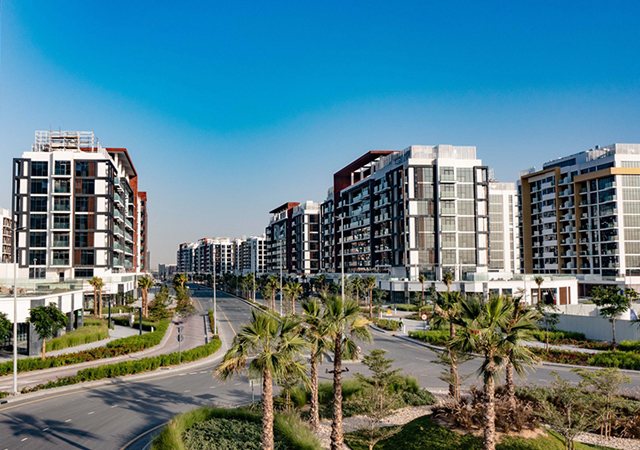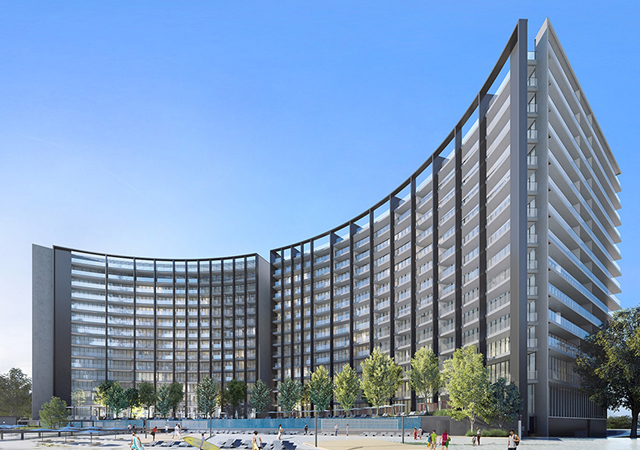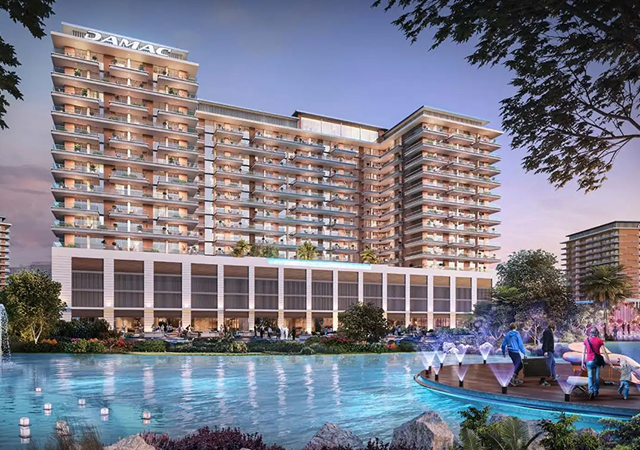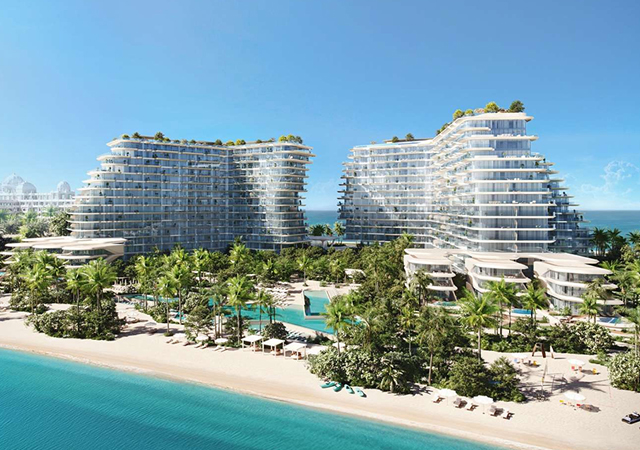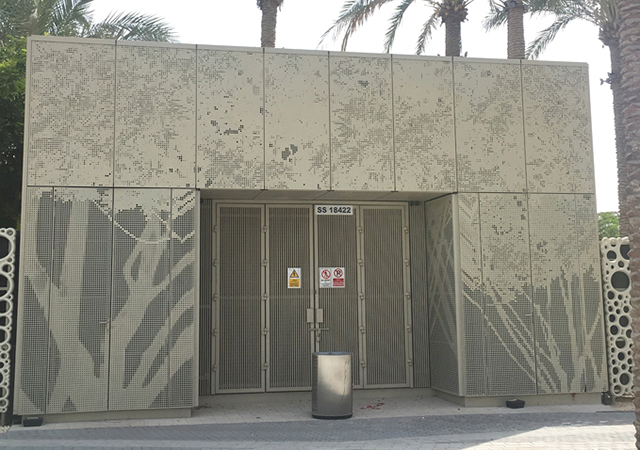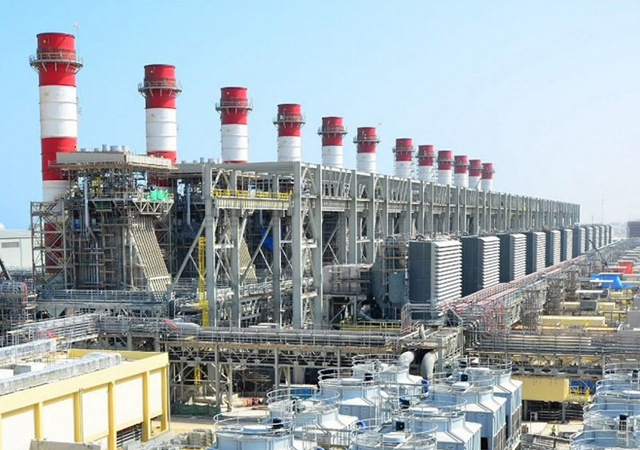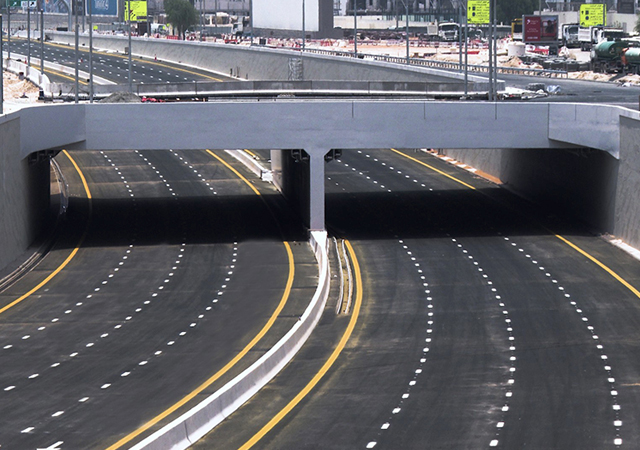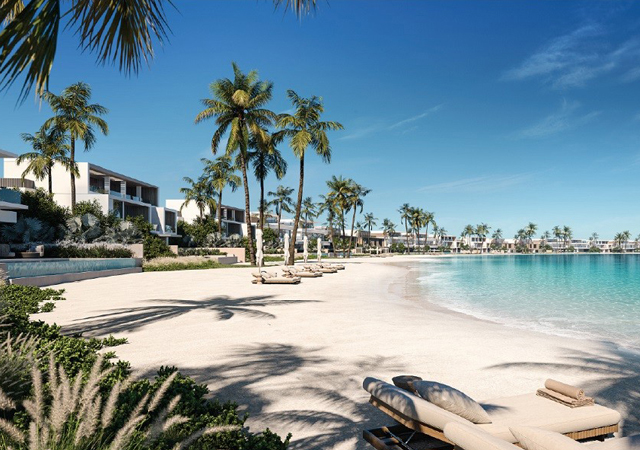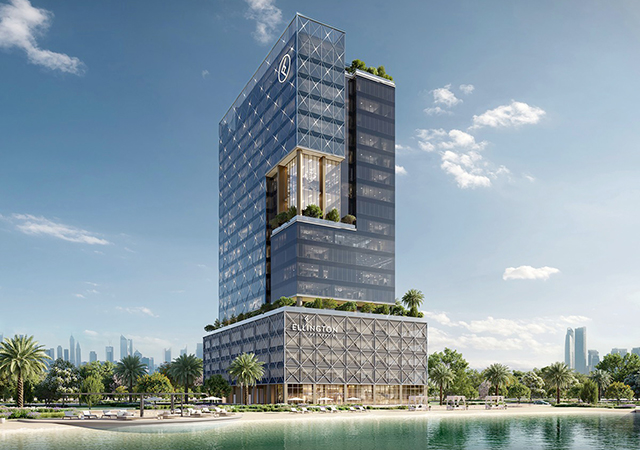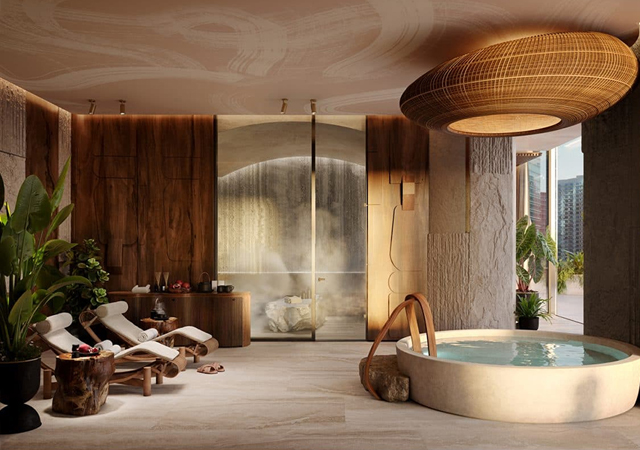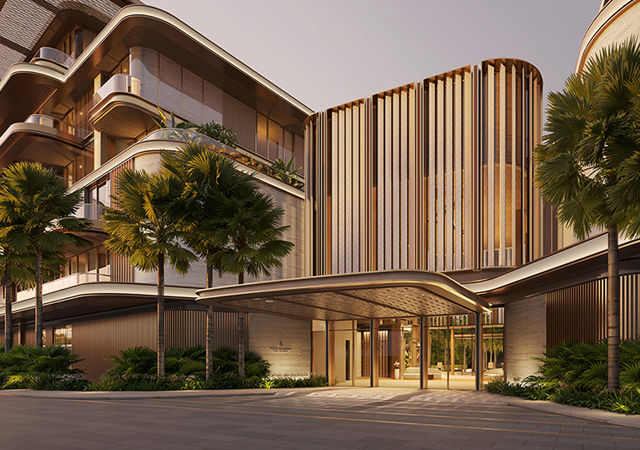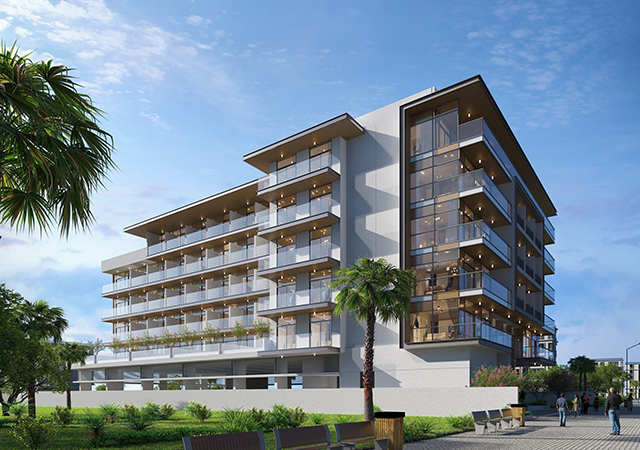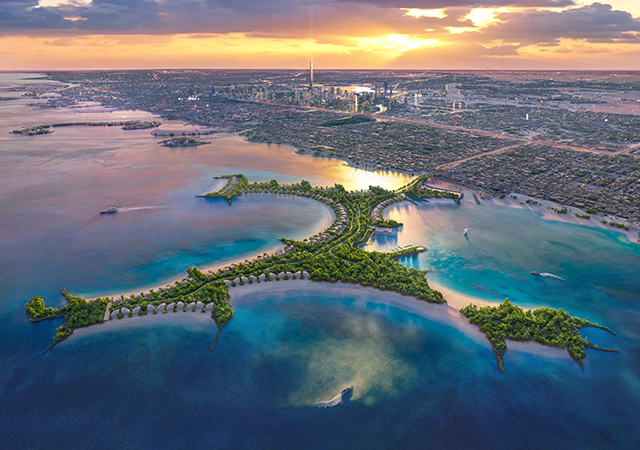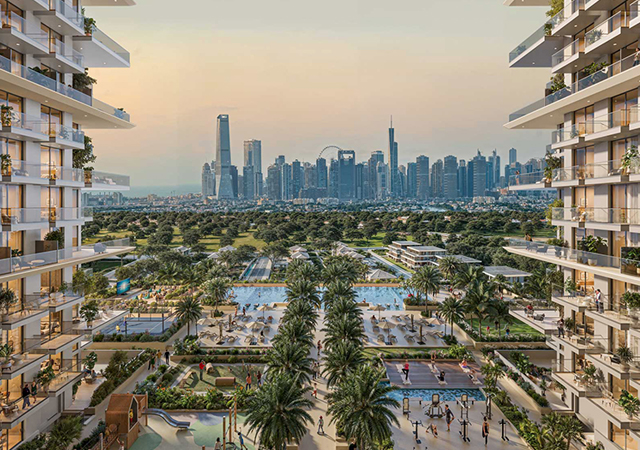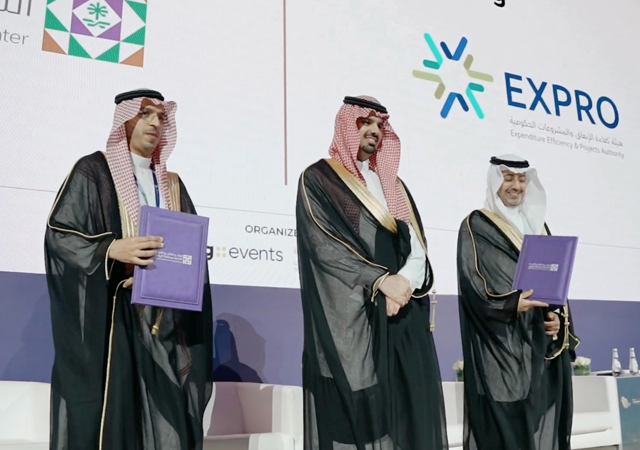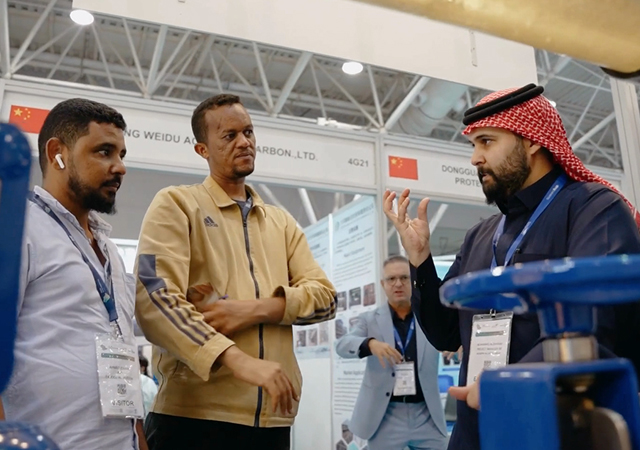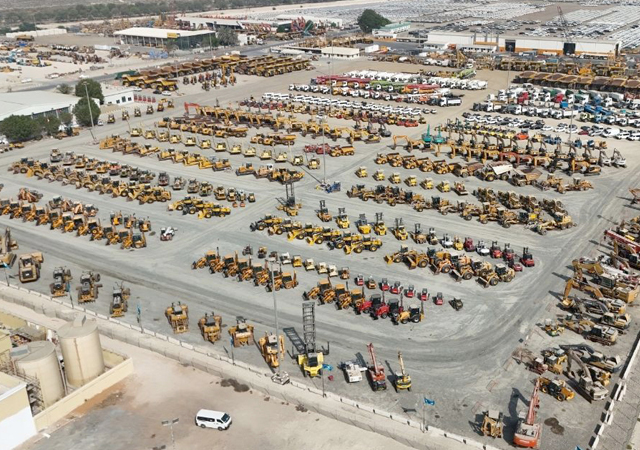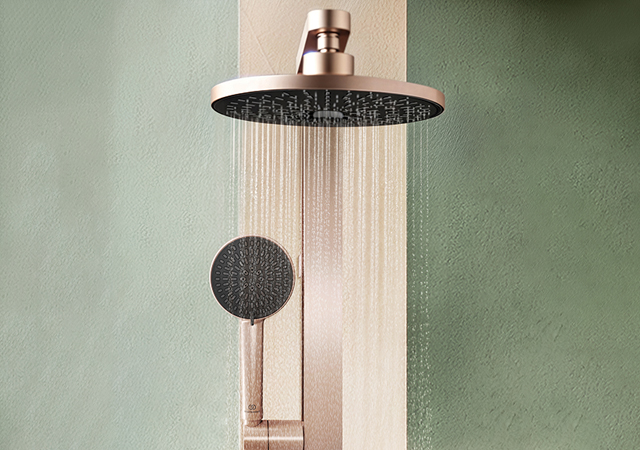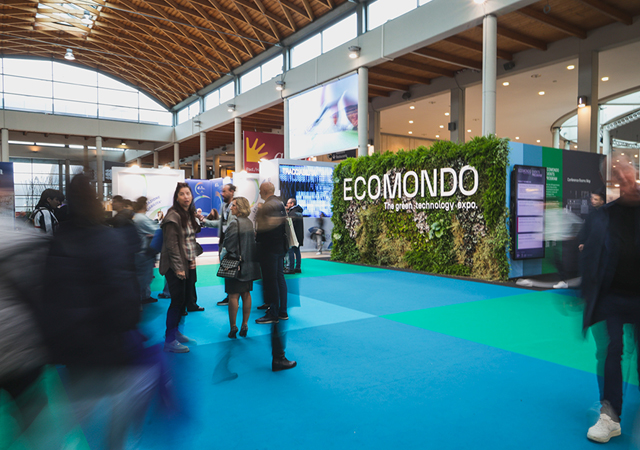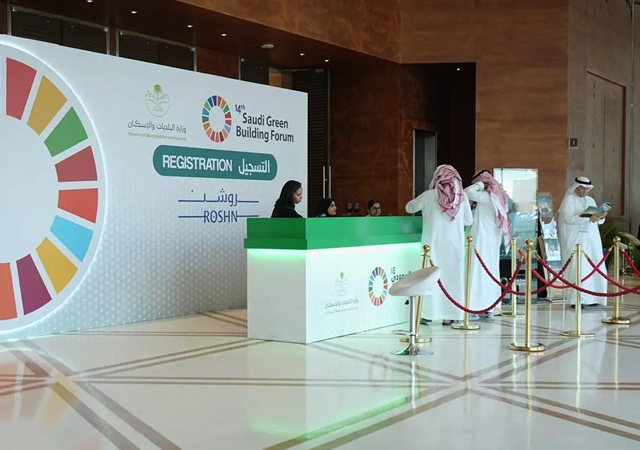
 Shaikh Zayed Road, a magnet for high-rise construction in Dubai.
Shaikh Zayed Road, a magnet for high-rise construction in Dubai.
There’s no stopping Dubai. From the tallest to the largest, to the most luxurious and the most hi-tech – the emirate is aiming for it all.
The vibrancy is palpable to every visitor the moment the aircraft touches down at Dubai’s showpiece airport. Right there, a forest of tower cranes surmount a cavernous excavation which is abuzz with concrete-mixers making a beeline towards the bottom where scores of workers are helping shape the international airport’s $4.1 billion expansion.
Looking beyond, spectacular skyscrapers interspersed with tower cranes dot the horizon. A drive down Shaikh Zayed Road certainly reinforces the impression. Projects are mushrooming alongside both sides of this highway – Kharbash Tower, Etisalat Tower, Damas Tower, Al Murooj, Dalma Tower, Al Yassat Tower, Mall of the Emirates, Dubai Marina… the list goes on.
Dubai’s ambitions seem to know no bounds as the emirate pursues at a frenetic pace the government’s Vision 2010, which aims to cater to 15 million visitors a year.
Major projects being undertaken by Emaar Properties, Nakheel, Union Properties, Dubai Tourism Development Company and other developers, have given a tremendous boost to construction, earning the emirate the status of the construction power house of the region.
The emirate’s recent construction projects have been truly pioneering and unprecedented in design, scale and scope, whether it is the Dh20 billion-plus ‘Dubailand’ project which aims to bring Disneyland to the Gulf, or the Burj Dubai, the world’s tallest building, or the Dubai Marina which is considered to be the largest masterplanned community in the world, or the ambitious Palm Islands and The World, which have grabbed headlines around the globe. Among the latest projects to get the go-ahead is a Dh14.3 billion metro.
Some of the other mind-boggling array of projects are the Dubai Festival City, Dubai International City, Mall of the Emirates, Dubai Pearl, Dubai Healthcare City, Dubai International Financial City, Dubai Textile City – the emirate certainly is looking at catering to all sectors of the economy.
The emirate offers immense opportunities not only for contractors and building materials suppliers in the UAE but those in the GCC countries who could benefit immensely by participating in the construction boom of Dubai, says one leading contractor.
According to a recent report, Dubai’s construction sector has witnessed strong growth in the last few years and it now contributes 17.2 per cent to the emirate’s GDP.
In 2003 Dubai Municipality issued 21,293 building licences, an increase of 21.97 per cent compared with 17,457 licences issued in 2002, according to Khalid Mohammed Saleh, head of the Municipality’s Building Permits and Systems Section.
The number of building permits issued by Dubai Municipality in January this year alone stood at 1,702.
Given the scale and pace of construction, there is a shortage of building materials such as cement and steel, and costs are escalating which inevitably will push the contract values higher and could affect the momentum in the industry.
The question now on everyone’s lips is how long will the bubble last?
“A time may come when you could buy a new apartment cheaper than you can get an old one – that’s when prices will crash,” warns one industry source.
Another section of the industry believes that the bubble is only getting bigger while others say caution needs to be taken to ensure that there isn’t a major economic setback.
However, Dubai has put in place a strategy which seems to spawn further projects to support the various developments taking place. The relatively recent phenomenon of freehold property for expatriates has given a tremendous impetus to the real estate sector and this promises further growth at least in the medium term.
There is concern whether the emirate’s infrastructure will be able to cope with the break-neck speed of developments. Some consultants advise that Dubai should turn towards private-public partnerships (PPPs) to ensure that the essential utilities such as power, water and road networks are being developed in tandem with the demand in growth.
Airport & airport expo centre
Dubai International Airport’s (DIA) $4.1 billion expansion is expected to be completed by 2008 to serve over 70 million passengers per year by 2020.
The first phase of the project will be completed by 2007, followed by the total handover of the project by the contractors to the Dubai Civil Aviation (DCA) in 2008. Under Dubai’s Vision 2010, the emirate’s annual tourism inflow is to reach 10 million, while passenger traffic through DIA is to exceed 30 million.
In line with these projects, DIA expansion plan had been initiated in the late 1990s to increase the airport’s capacity to cater to 60 million passengers by 2020. A new study indicates that DIA will have to cater to over 70 million passengers by 2020. The expansion plan, therefore, has been revised (see page 54).
Meanwhile, planning work has begun on the proposed expansion of Airport Expo Dubai, a purpose-built exhibition site for the Dubai air show.
Initial plans are being drawn up to further develop facilities at the complex, including creating more car-parking space, possible expansion of one or both of the two exhibition halls and the creation of an on-site conference centre.
These additional facilities are needed to cope with increased demand for the Dubai air show and to ensure it lifts its ranking among the top four aerospace exhibitions in the world.
Commercial & leisure complexes
Construction work has begun on the Dh21 billion Dubailand, the emirate’s largest tourism project. The project will have six clusters, including Attractions and Experience World, Sports and Outdoor World, Eco Tourism World, Themed Leisure and Vacation World, Retail and Entertainment World and Downtown.
Dubailand with two billion sq ft of developed infrastructure and world-class facilities – including entertainment, retail, sports and theme parks – will be double the size of Disneyworld.
Dubailand will redefine leisure tourism in the region and help Dubai become the ultimate fun and leisure centre of Middle East and the only one between Hong Kong and France.
The first few clusters will be operational by 2006 and 2007 and will include the Dubai Sports City, Global Village and Aqua World. The entire project will take between 10 and 15 years to complete. However, some sections will be operational by 2007 (see page 36).
More than 100 investors have shown interest in the land development projects announced by Dubai International Financial Centre (DIFC). According to Land Company, the land development arm of the Centre, these include possible bidders from the US, Switzerland and Monaco and regional investors from Kuwait and Saudi Arabia.
The land development plan envisages the creation of state-of-the-art infrastructure and scores of high-rise buildings on the 110-acre DIFC site within six and a half years.
The land earmarked for DIFC is divided into eight districts. The Gate, where the DIFC will have its offices, and the six buildings surrounding it, will be developed by the centre itself and is expected to be completed next year.
The huge investments in DIFC’s property development, which is said to be larger than Canary Wharf, will trigger the flow of large foreign direct investments into the country, according to DIFC.
An island representing the UAE in Nakheel’s ambitious project – The World – has broken the surface of the Arabian Gulf in less than six months of construction. The UAE island itself will cover a total land area of 17,396 sq m, with a circumference of 501 m and a landmass of 600,000 cu m.
“With several million cu m of sand and rock having already been placed, the entire development has clearly begun to take shape”, said Sultan Ahmed bin Sulayem, chairman of Nakheel.
In addition to the UAE island, work is progressing rapidly on the islands of North America, South America and the footprints of the two protective breakwaters, he said.
Construction is well under way on The Palms project, Al Nakheel’s first major project. Work on a bridge connecting the Palm Jumeirah to the mainland. The 350-metre long, 25-metre wide bridge will provide the entrance to the residential, tourism and leisure development. It is scheduled for completion by the end of this year.
Reclamation work on The Palm, Jebel Ali is moving ahead rapidly with a forecast completion towards the end of 2005. A team of more than 300 workers, 14 barges, 11 tug boats, four dredgers and 10 other vessels are working round the clock to ensure the strict deadline for construction of the island is maintained (see page 47).
Construction work on the first phase of Dubai International City, conceived as a mixed residential and retail venture targeted at the middle-income market, is under way and will be ready in the second half of this year.
Being developed by Nakheel, the project covers more than 800 hectares in Al Warsan on the northern side of Dubai and is expected to be completed end of 2006.
The City will offer affordable residences for those working in the free zones in those areas, such as the Textile City. With components such as the Dubai Gates, The Dragon Mart and Forbidden City, Dubai International City aims to create planned townships drawing on design elements from China, England, Italy, France, Russia and Morocco. DMJM International of the US is the master planner for the project.
The Chinese component of the City is already in an advanced state of construction — the retail element will have more than 3,000 Chinese companies exhibiting their products. The residential sector has already been taken by Chinamex, a Chinese company.
In all, there will be 20,000 apartments and 350 buildings within the City. In the heart of the City, the Central District will cover 21 hectares. Independent developers will be allowed to bid for the 34 plots forming this block.
Other Nakheel projects include Jumeirah Islands, Jumeirah Lake Towers and The Gardens Shopping Mall. Projects already completed include The Gardens residential community.
Work has been launched on Emaar’s Burj Dubai, the tallest tower in the world, with the award of the foundations contract on the project. The Burj Dubai development,located on a 400 acres-plus plot, will also feature The Residences – a six-tower residential complex, and the Dubai Mall, which is targeted at being the largest of its kind in the world. A key feature of the mall will be a series of hi-tech, state-of-the-art atriums designed to host events and activities on an international scale (see page 44).
Work is well under way on the Dubai Marina, another major Emaar project. This development is described as the world’s largest masterplanned waterfront development of its kind. It will be the region’s first ‘intelligent city’ that will eventually house 35,000 people in luxurious residential towers, villas and hotels.
Covering an area of 4.5 sq km and featuring a 3.5 km long man-made lagoon, it will provide almost nine km of marina frontage; starting at the Dubai International Marine Club and returning to the ocean just beyond the Sheraton Jumeirah, some 25 km from Dubai’s city centre.
A major component of the development which is set to take shape is the Jumeirah Beach Residence, a whole new concept of luxurious homes offering a year round beach resort lifestyle at affordable prices on freehold ownership basis.
With 35 residential towers comprising 6,300 housing units and four hotel towers, Jumeirah Beach Residence will cater to a community of 25,000 people in a 1.7 km stretch of development containing a total built up area of 22 million sq ft It will offer different apartment types ranging from studios to one to four bedrooms and a choice of special apartments.
Al Rostamani has launched work on a 50-storey tower at the Dubai Marina, following the completion of the 21st Century Tower on Sheikh Zayed Road, which boasts the distinction of being the world’s tallest residential tower.
Besides, the Burj Dubai and the Dubai Marina, Emaar currently has 10 other major real estate projects under various stages of development. These developments include Dubai Marina Villas, Arabian Ranches, Gazelle, Emirates Hills, The Meadows, The Springs, The Lakes, Hattan, The Greens, and Emaar Towers in downtown Dubai. The company also owns and manages the Gold and Diamond Park.
Work is in full swing for the development of a state-of-the-art Clubhouse at The Desert Course, part of another Emaar project, the prestigious Arabian Ranches development.
Covering an area of 35,000 sq ft, the facility features conference rooms for seminars besides accommodation for students. The Clubhouse will be the headquarters of the UAE Golf Association and National Golf Centre.
The Clubhouse will be the centerpiece of The Desert Course and the Arabian Ranches development as a whole. It will be equipped with state-of-the-art facilities within a modern and upscale environment.
The 7,691-yard Desert Course has been designed by Ian Baker-Finch, in association with Nicklaus Design. Apart from an enormous lake adjacent to the upcoming clubhouse, the course does not feature water hazards unlike regular golf courses. Other features include the absence of bunkers, even when the whole course is effectively in one huge sandpit, and a GPS (Global Positioning System) yardage service. The latter, the first of its kind to be introduced in the region, relays the distance from the tee to the hole within one meter accuracy while a map inside the cart provides the pin placement.
Work is set for completion this year on the Madinat Jumeirah, a majestic resort which is taking shape of the Jumeirah coastline. The three-phase project involves the construction of two five-star hotels, 29 authentically-designed Arabic villas, a convention cente, a health spa and a suq area.
Construction work on Dubai Festival City resumed last month following the closure of Global Village 2004, the international attraction of the Dubai Shopping Festival.
The InterContinental has been chosen to manage the Conference hotel within the complex (see UAE Focus).
Dubai Festival City is being developed on 1,600 acres on the banks of Dubai’s historic Creek. The project comprising 15 distinct development zones, is a property development by the Al-Futtaim Group and is the Middle East’s largest, privately funded mixed-use real estate project.
It will comprise a unique mix of entertainment, dining, shopping, edutainment, sport and leisure facilities, automotive dealerships, hotels, a marina, residential and office components.
For sporting enthusiasts, an 18-hole championship golf course, designed by world-renowned golf course designer Robert Trent Jones II, and other world-class sporting facilities are also being incorporated into the overall development.
Another major project under way is the Dh3 billion ($816 million) Dubai Pearl community centre development. It comprises three hotel towers with more than 1,500 hotel rooms and suites, an 1,800-seat performing Dubai Royal Hall, a 200,000 sq ft galleria, six residential towers with 2,200 plus apartments and over 1.2 million sq ft of shops, restaurants and promenades, in addition to a TecnoWorld.
Majid Al Futtaim Investments is building one of the largest malls in the region next to Interchange Four on the Sheikh Zayed Road. Khansaheb has started work on the Mall of the Emirates, which was formerly known as Souk Al Nakheel. The mall will be ready to open in September 2005. With over 350 shops and more than 2.4 million sq ft of prime retail and leisure space, it will be the biggest Mall outside North America.
The Textile Merchants Group (Texmas) has launched the Dh220 million Textile City to help promote the emirate as a major trading hub.
Dubai Textile City is to be built on approximately six million sq ft of land in Al Warsan area. The project has been awarded to United Engineering Contract (UNEC) and will be completed by mid-2005 (see UAE Focus).
Meanwhile, one of Dubai’s leading shopping centres, the BurJuman Center, will soon see the completion of its mega expansion. On the retail side, space will almost treble to 800,000 sq ft from the current 300,000 sq ft.
The complex will also feature a 22-storey commercial office block with state-of-the-art offices, a hi-tech business centre, a 20,000 sq ft exclusive conference hall, Internet facilities, cafes, a fully equipped gymnasium and other sports facilities. On the residential side, BurJuman will also comprise 163 furnished and semi-furnished condominiums in addition to a block of fully furnished luxury apartments (see page 63).
The Abbco Group is constructing the world’s tallest all-suite hotel, Forex Rotana, at a cost of Dh250 million. Once built, the 72-storey, 380-m-high structure will cater to the members of the global financial trade community (due to its close proximity to the Dubai International Financial Centre).
It will be the tallest all-suite hotel in the world. Once completed, it will be verified by the Guinness Book of World Records to enter the project in its list of records. The hotel will also have three floors of ready-made offices and residences that will be rented out on a short and long term basis.
Another project catering to the corporate sector is being launched by Lootah Real Estate Development.
Located near the Jebel Ali Free Zone, Evan Residence is the first corporate residential project available for purchase in the UAE. Covering an area of two million sq ft in Dubai Investment Park, it comprises 75 buildings (see UAE Focus).
Dewan Al Emara Architects and Engineers is designing and supervising a 30-storey Thuraya Tower at Dubai Media City. The tower will be located at the side entrance of Dubai Media City and will overlook the Dubai Marina.
Excavation and foundation work are under way at the site. The tower is expected to be ready for commercial office occupation by mid 2005.
Water & electricity
Dubai Electricity and Water Authority (Dewa) and the Emirates Trading Agencies have given the go ahead to a Dh347 million ($94.47 million) project to improve Dubai’s electricity transmission.
The project involves construction of nine major substations and aims at enhancing the reliability of Dewa’s transmission network.
The substations and new cable network will be at Jebel Ali Free Zone (JAFZ), International city, Arabian Ranches and the Dubai International Financial City.
The extension to the structure is part of Dewa’s master plan for the area. Construction of the substations has already started.
Dewa has also awarded an engineering consultancy contract for Phase II of the L station in Jebel Ali to Lahmeyer, one of the biggest power generation projects in the emirate. The facility will have an installed capacity of 1,200 MW and 50 million gallons of water a day. The plant is scheduled to become operational in phases in 2007 and 2008.
Another engineering consultancy services contract was awarded to Mott MacDonald for Phase II of the Awir gas turbine power station. It will have a capacity of 400 MW with three gas turbines. Commissioning is set for 2006.
Roads & railways
Construction work is well under way on the 1.5 km-long tunnel below the Dubai International Airport.
The tunnel – expected to be the longest and the widest in the Middle East – will become one of the principal ‘landmarks’ of Dubai, and will also free up traffic moving from the Dubai Creek towards Sharjah.
Work is being implemented in five phases as part of a Dh686 million road network scheme around the airport. It is to be ready by March 2005.
The tunnel, with four lanes in each direction, will help solve the traffic congestion between Sharjah and Dubai as it will offer a new link between the Sharjah borders and Dubai. The tunnel will give motorists a direct route from Sharjah to Sheikh Zayed Road.
New interchanges and another seven shorter tunnels are also under construction and the main tunnel will replace Rashidiya Road. The smaller tunnels will give smoother access to Terminal Three. A new interchange is also being built on Al Garhoud Road to ease traffic from the Cargo Village.
As part of the project, all roads around the airport will be linked in the near future to cope with the massive airport expansion plans that are under way, given the volume of traffic that such expansion could spawn.
Designers have ensured the tunnel meets all international road safety standards, including fire detection systems, hi-tech signs, high-powered ventilation systems and police surveillance cameras.
Among other developments, the road network around BurJuman Center is being expanded to ease the flow of traffic. The new roads will further enhance the beautiful landscape of the Dh1.4 billion expansion project that is now under way to develop BurJuman into a total destination.
The project includes the improvements on key roads such as Sheikh Khalifa bin Zayed Al Nahyan Road (Trade Centre Road), Khaled Bin Waleed Road, Kuwait Road and Al Mankhool Road, and construction of signalized junctions on internal roads.
The road development programme, which is scheduled to be completed shortly, will feature the use of advanced traffic simulation software to minimise customer travel discomfort.
Dubai Municipality will be replacing all eight bridges on Shaikh Zayed Road by 2007. Work on Interchange Four has been completed. However the road that leads to Al Nakheel Market is not yet ready as its completion is tied up with the construction of the market.
Interchange Four is a key junction on Sheikh Zayed Road because it is located near several hotels and resorts such as the Burj Al Arab, the Madinat Jumeirah Resort, Emaar projects, Dubai Internet City and Dubai Media City and others.
The interchange, replaced with free-flow bridges in set directions, also serves the Palm Islands project and Emaar projects.
The old bridge was demolished and new bridges were built on the same interchange. The length of the first bridge is 330 m in addition to a 35 m stretch leading from Al Barsha and Al Quoz to Jumeirah and Umm Suqeim. The second bridge is for traffic coming from Dubai to Jumeirah, Al Sufouh, Al Barsha, and Al Quoz. This bridge was opened to traffic before the beginning of the Dubai 2003 world financial meetings.
Meanwhile, tenders are expected to be announced within the next two months on the Dh14.3 billion metro. Construction work is expected to start in October 2005 with the first phase scheduled for completed by 2010 and the two main lines due to be fully open three years later.
Dubai Metro System will carry around 1.2 million passengers daily and 355 million people a year. It will include 55 stations, both elevated and underground, and 18 km of tunnels, 51 km of viaduct, one major train depot and a maintenance workshop and several auxiliary offices.
The system will be fully integrated into the Dubai Municipality Public Transport Department. Bus stops, several taxi stations and park and ride centres will complement the rail system. While 35 stations will be situated along the 50-km Red Line, 22 stations will serve the 20 km Green Line.
The two transfer stations will be situated at Al Ittihad Square and the BurJuman mall. A possible extension of the Green Line from Wafi to Dubai Festival City is also being studied. Both lines will run underground in the city centre because of logistical convenience. Elsewhere, the trains will travel over an elevated and specially designed viaduct to augment safety.
Other projects
- Dubai Municipality has unveiled preliminary designs for Oud Metha Neighbourhood Park, to be built over 1.34 hectares. The park would include several facilities and features such as playgrounds for children of various age groups, a vast green area, traditional irrigation canal or Al Falaj, small lake with water fountains, traditional well in the middle of an open piazza, in addition to shaded areas, cafeteria and public toilets.
- The Dubai Investments Park Development Company (DIPDC) has announced a comprehensive development plan for Phase 3 of its huge Park project. The park’s location has become even more significant following the announcement of the Dubailand project.



